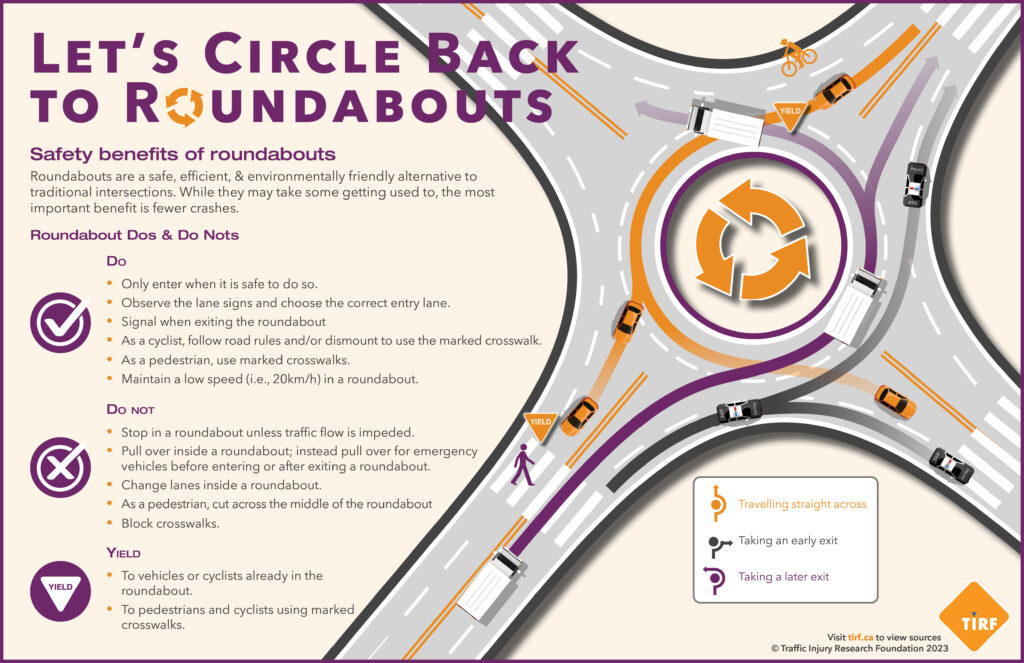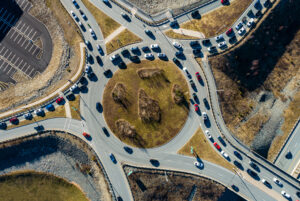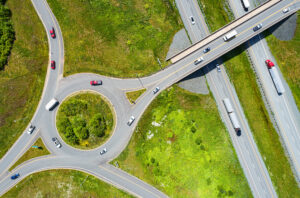Benefits of roundabouts: safety, low speeds, the environment & more!
Chances are we’ve all seen and driven through a roundabout given their rapid proliferation during the last decade in North America. Since 1990, roundabouts have become an increasingly popular road safety design to replace intersections which rely on stop signs and traffic lights. Many drivers may view roundabouts as confusing or inconvenient simply because we aren’t as familiar with them.
Download our new infographic in JPG or PDF.
Safety benefits of roundabouts
Did you know they are actually safer than traffic signals and stop signs? This is because roundabouts use curved approaches that reduce vehicle speed and oblige drivers entering it to yield right-of-way to vehicles already in the roundabout. The counter-clockwise flow of traffic around a central island also minimizes conflict points (i.e., opportunities for collisions). Lower speeds make it easier for drivers to yield to oncoming vehicle and pedestrian traffic because less stopping distance is needed. In addition, the circular shape greatly reduces the likelihood of angle or T-bone collisions which are common at intersections and which increase injury severity.
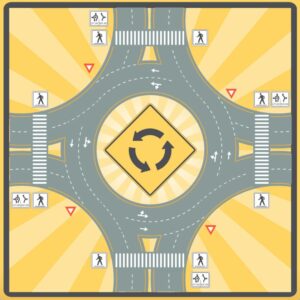
This design is also more protective of cyclists and pedestrians because typical speeds in roundabouts are 20-30km/h, at which active transportation users are more likely to survive in the event of a collision. While research suggests when roundabouts are first implemented there tends to be a small increase in crashes, these are most often more minor rear-end collisions. This increase also disappears as drivers learn how to safely navigate a roundabout.
When used correctly, roundabouts are generally safer for pedestrians. Pedestrians use sidewalks around the perimeter and cross only one direction of traffic at a time. Crossing distances are relatively short and traffic speeds are lower than at traditional intersections as vehicles slow down to yield at the roundabout.
Where do roundabouts work best?
Roundabouts are appropriate at many intersections, including high-crash locations and intersections with large traffic delays, complex geometry (e.g., more than four approach roads), frequent left-turn movements, and relatively even traffic flow. Roundabouts can be built along congested arterials and at freeway exits and entrances to replace traffic signals.
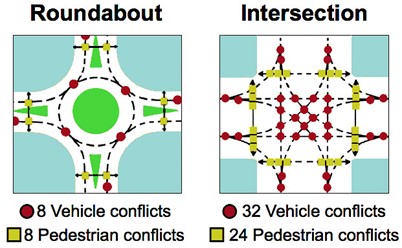
Myths & misperceptions about roundabouts
Roundabouts accommodate fewer vehicles than other intersections
False. In fact, the volume of vehicles flowing through a roundabout is typically much greater and faster as compared to stop lights/signs. Intersections controlled by traffic lights require drivers travelling in two of the possible directions to stop while the other two flow through the intersection in a short, pre-determined duration of time.
Blowing through amber lights and running red lights is clear evidence of driver impatience in this scenario creating incredibly high risk. And the choreography of stop signs is even worse because every driver must come to a complete stop which often results in confusion about right-of-way leading to the competing hand wave of who should go first. On the other hand, roundabouts allow all drivers from all directions to advance consistently and much more quickly. Not to mention it removes the tempting ringing, chiming, beeping, buzzing call of the cell phone (a.k.a. that illegal, unsafe, risky, dangerous activity) because we all know, when succumbing to temptation to briefly engage with a phone while stopped at an intersection, it’s NEVER JUST TWO SECONDS.
It may be counter-intuitive, but this is also why we see roundabouts at higher traffic locations and busy areas such as school drop-off zones because they can manage higher volumes of traffic more efficiently and safely.
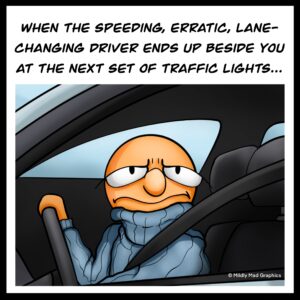
Roundabouts increase drive times
False. Roundabouts actually improve traffic flow because vehicles are constantly moving in a single direction. This means there is less need for stopping and starting which slows you down on the way to your destination, and results in drivers speeding between traffic lights.
We’ve all witnessed the speeding, erratic, lane-changing driver racing from one intersection to another (yes, also extremely unsafe because roads are not racetracks) only to find them sitting beside you at the next set of traffic lights.
Roundabouts are complicated to navigate
False, you just need to know how they work. A roundabout is based on the same premise as making a right turn from a stop sign which we’ve all done countless times.
At a traffic signal, a right-turning driver stops, looks for moving traffic coming from the left, glances both left and right for pedestrians and cyclists, chooses an acceptable gap (there are certainly wide differences in perception about what’s acceptable) in vehicle traffic, so they can complete their turn and enter the closest lane. Yes, the topic of gap acceptance and which lane of traffic to enter is a whole other issue…perhaps for another blog…but, the principle remains the same.
Similarly at a roundabout, the oncoming driver approaches the yield line, looks for oncoming traffic from the left, chooses an acceptable gap (yes, we know) in the traffic flow, and then enters the roundabout with a right turn at the yield sign. Once in the roundabout drivers continue circling counter-clockwise until reaching the desired exit. And, unlike intersections, if you miss your turn, you get a do-over by simply circling again. Exit manoeuvres are also right turns.
However, a main difference is drivers signal a turn prior to coming to a stop at an intersection whereas in a roundabout drivers signal to indicate their intention to exit. Of course, it becomes a little more complex in roundabouts with two or more lanes because often the lane you’re in is an indication of where you intend to exit. Either way, use of the turn signal is important for other drivers to know your intentions regardless of whether you’re at an intersection or in a roundabout (or, let’s face it, just simply changing lanes on a highway). Generally speaking, whether you’re turning right at an intersection or exiting right in a roundabout (Ministry of Transportation Ontario; Province of British Columbia), you must use your turn signal.
Roundabouts increase crashes
False. Roundabouts reduce crashes overall. This is assuming drivers yield right of way to oncoming traffic and travel at safe speeds. At intersections, the most severe types of crashes are T-bone, left turn, and head-on collisions. Roundabouts reduce opportunities for these types of crashes as well as the speed of impact; research shows 75% fewer crashes occur at roundabouts than at traditional intersections with lights. A number of jurisdictions have experienced short-term increases in rear-end crashes (until drivers become accustomed) when roundabouts are first implemented, however these collisions are more often minor in nature with fewer injuries.
Cyclists have two options when it comes to roundabouts
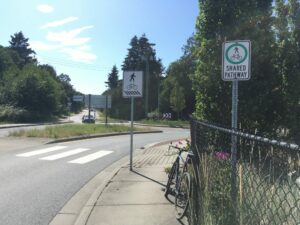
Cyclists have a couple of choices when it comes to roundabouts.
- Cyclists riding in a roundabout are also a vehicle and adopt similar practices such as yielding to oncoming traffic, merging with traffic and signalling to exit. Cyclists are afforded the same privileges as vehicle drivers and can take the lane and should use hand signals to indicate their intention to exit. Other drivers must likewise yield to cyclists as they enter and exit.
- Cyclists can also choose to use the marked crosswalk by dismounting to cross like a pedestrian.
Educating new and experienced drivers about roundabouts
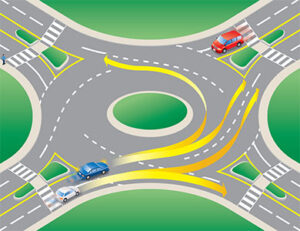
While roundabouts are commonplace in many European countries, it’s still a relatively new phenomenon for North America. To fully reap the benefits of this road design, it’s important to integrate knowledge of roundabouts into new driver training. This not only prepares new drivers to navigate them safely but allows this information to be passed along to parents or guardians involved in the many hours of required practice. At the same time, education and awareness campaigns are important to ensure experienced drivers understand how to navigate them.
Many provincial governments feature sections on their websites or in their driver’s handbooks on road rules for roundabouts. Ensuring this information is also made widely available to drivers through awareness and education campaigns goes a long way toward the successful implementation of this effective road design.
It’s also critical to remember that large vehicles like trucks and particularly emergency services vehicles like fire trucks need more room to manoeuvre and should be allowed the extra space to do so. These large vehicles often need to use the apron surrounding the centre island to have sufficient space to navigate the length of their vehicles.
Environmental impacts of roundabouts
What many drivers may not be aware of is the environmental benefits associated with roundabouts. They require less idling waiting for the green light which reduces vehicle emissions and fuel consumption. When you think about it, you typically spend less time at a roundabout than at a traffic light because the purpose of the roundabout is to enhance traffic flow and allow for the constant safe moving of vehicles. According to the Insurance Institute for Highway Safety (IIHS), roundabouts significantly decrease fuel consumption and emissions by as much as 30%. The IIHS states that roundabouts provide environmental benefits by reducing the number of acceleration/deceleration cycles and the time spent idling compared with traffic signals. Even with high traffic volumes, vehicles continue to advance in moving queues, rather than coming to a complete stop.
Roundabout Dos & Do Nots
Do
- Only enter when it is safe to do so.
- Observe the lane signs and choose the correct entry lane.
- Signal when exiting the roundabout.
- Maintain a low speed (i.e., 20km/h) in a roundabout.
- As a pedestrian, use marked crosswalks.
- As a cyclist, follow road rules and/or dismount to use the marked crosswalk.
Do Not
- Stop in a roundabout unless traffic flow is impeded.
- Pull over inside a roundabout; instead pull over for emergency vehicles before entering or after exiting a roundabout.
- Change lanes inside a roundabout.
- Block crosswalks.
- As a pedestrian, cut across the middle of the roundabout.
Yield
- To vehicles or cyclists already in the roundabout.
- To pedestrians and cyclists using marked crosswalks.
Despite their many advantages, roundabouts can take some getting used to, and there are some common misconceptions about how they work. Overall, roundabouts are a safe, efficient, and environmentally friendly alternative to traditional intersections and are likely to become increasingly common as traffic planners continue to prioritize safety and sustainability in their designs. While they may take some getting used to, drivers can rest assured that navigating a roundabout is a road design consistent with other road designs and rules.
Besides, if we can master roundabouts, just imagine the benefits of peanutabouts, but one step at a time. We’ll keep that topic for another blog.
#MySafeRoadHome blog co-authors: Hannah Barrett, TIRF Researcher and Program Coordinator; Karen Bowman, Director, Communications & Programs; and, Robyn Robertson, TIRF President & CEO work collaboratively as co-authors. Hannah is a criminologist and specializes in alcohol ignition interlock programs, wildlife-vehicle collisions, and impaired driving countermeasures. Karen is uses her writing and blogging background to help apply TIRF’s research to real-world driving, cycling and walking. Robyn is the author of TIRF’s knowledge translation model, is well-versed in implementation strategies and operational practices across several sectors.
Related topics:
 |
 |
 |
 |
Source documents and resources:
Nearly 20,000 vehicles went through red lights in Hamilton in 2022, according to city camera data, CBC News, March 18, 2023 https://www.cbc.ca/news/canada/hamilton/red-light-cameras-2022-1.6783209
Understanding & Preventing Distractions on the Road: #Infographic, TIRF #MySafeRoadHome blog, https://tirf.ca/blog/understanding-preventing-distractions-on-the-road-infographic
Brilon, W. (2011, May). Studies on roundabouts in Germany: lessons learned. In 3rd International TRB Conference on Roundabouts, Carmel, Indiana. https://www.ruhr-uni-bochum.de/verkehrswesen/download/literatur/Brilon_roundabouts_2011_05_29_cit.pdf
Daniels, S., Brijs, T., Nuyts, E., & Wets, G. (2010). Explaining variation in safety performance of roundabouts. Accident Analysis & Prevention, 42(2), 393-402. https://www.sciencedirect.com/science/article/abs/pii/S0001457509002280
Polders, E., Daniels, S., Casters, W., & Brijs, T. (2015). Identifying crash patterns on roundabouts. Traffic injury prevention, 16(2), 202-207. https://www.tandfonline.com/doi/abs/10.1080/15389588.2014.927576
Sakshaug, L., Laureshyn, A., Svensson, Å., & Hydén, C. (2010). Cyclists in roundabouts—Different design solutions. Accident Analysis & Prevention, 42(4), 1338-1351. https://www.sciencedirect.com/science/article/abs/pii/S0001457510000606
IIHS (June, 2022). Roundabouts. https://www.iihs.org/topics/roundabouts
